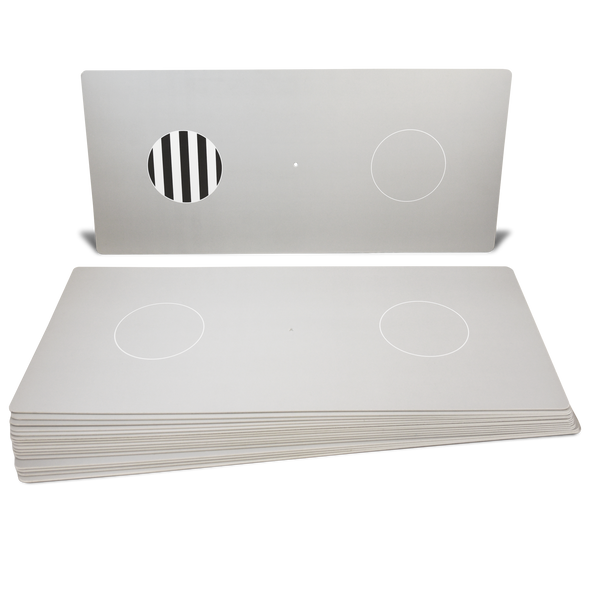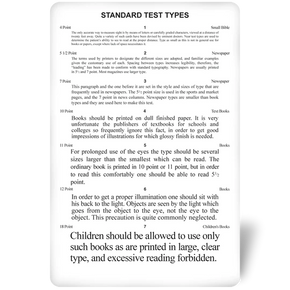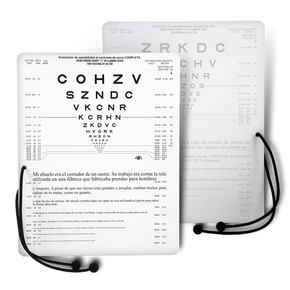
LEA GRATINGS® Low Contrast Test
These discs measure contrast sensitivity curve based on 4 gratings at 2 contrast levels: 10% and 2.5% contrast. These 2 levels use 2 grating frequencies: the 10% level uses 0.5 cpcm and 8 cpcm while...

 US FDA Registered
US FDA Registered






KAC Children’s Grating Test provides a rapid method of determining the visual acuity of infants and young children. The KAC Set is based on the techniques of the Teller Acuity Test pioneered in the United States which was later adapted, tested and used in clinical practice in Europe as the Keeler Acuity Cards (KAC) for many years. This technique is based on infants' known “preference" for patterned stimuli (preferential looking) as indicated by their looking behavior.
The test includes 18 cards in two sections:
1. Infant Assessment Set consists of eight acuity cards. Each card contains two circular apertures administered at 38 cm. In seven of the cards one of the apertures contains a grating patch of known spatial frequency (i.e. the number of black and white stripes per degree of visual angle). The eighth card does not contain a grating in either aperture--this is marked the "blank". A small round peep-hole is located at the center of each card through which the patient is observed during the test. This set covers LogMAR 0.4 ( Snellen 20/20) to LogMAR 2.2 (Snellen 20/3400)
2. Children’s Additional Set provides a further set of 10 cards with 4 cards in the nominal acuity range 14.5 to 35.4 c/deg (LogMAR 0.3 to –0.1 or Snellen 20/40 to 20/17), and six cards within the range of 0.29 to 9.6 c/deg (LogMAR 2.0 to 0.5 or Snellen 20/2100 to 20/60 -). The additional cards extend the KAC Children’s Grating Test assessment beyond the first year of life and provide greater sensitivity when testing acuities are below 12.5 c/deg.
The KAC Children’s Grating Test supports efficient vision testing of children from a few months old to about 3 years old . Once the administrator is familiar with handling these cards, this test takes only five to 10 minutes to complete for both eyes. In addition, adult, non-verbal patients can also be tested with the Gratings. References and Clinical Trial documents shown under Additional Images tab or available on request.
Test cards are 10.5 x 22.5 inches and include peep hole in center for the examiner to see the child’s eye movements and avoid the distraction of the examiner’s face. The cards are made with a plastic composite for durability and come boxed.
Note: All products sold on Accuspire.com should be used by qualified clinician and should be purchased by or on order of a qualified clinician.






These discs measure contrast sensitivity curve based on 4 gratings at 2 contrast levels: 10% and 2.5% contrast. These 2 levels use 2 grating frequencies: the 10% level uses 0.5 cpcm and 8 cpcm while...

The Standard Reading Test Card has 7 reading examples in the following Letter Point Sizes: 4, 5.5, 7, 10, 11, 12, and 18. The text examples mimic Small Bibles, Newspapers, Books, etc.

Near Vision, Card that combines both high Contrast characters on one side and 10% low Contrast on the opposite. Each side contains both ETDRS format Sloan Letter, and continuous text reading,...

The Dominant Eye test card quickly and easily determines a patient's dominant eye. Screen printed on long-lasting styrene plastic with instructions right on the card.Dimensions: 10" x 6" (25.4 cm x...

This card combines a LEA SYMBOLS® line test on one side and a LEA NUMBERS® line test on the opposite side. Features proportionally-spaced lines from sizes 20/400 to 20/10 (6/120 to 6/3)...

These discs measure contrast sensitivity curve based on 4 gratings at 2 contrast levels: 10% and 2.5% contrast. These 2 levels use 2 grating frequencies: the 10% level uses 0.5 cpcm and 8 cpcm while...

The Standard Reading Test Card has 7 reading examples in the following Letter Point Sizes: 4, 5.5, 7, 10, 11, 12, and 18. The text examples mimic Small Bibles, Newspapers, Books, etc.

Near Vision, Card that combines both high Contrast characters on one side and 10% low Contrast on the opposite. Each side contains both ETDRS format Sloan Letter, and continuous text reading,...

The Dominant Eye test card quickly and easily determines a patient's dominant eye. Screen printed on long-lasting styrene plastic with instructions right on the card.Dimensions: 10" x 6" (25.4 cm x...

This card combines a LEA SYMBOLS® line test on one side and a LEA NUMBERS® line test on the opposite side. Features proportionally-spaced lines from sizes 20/400 to 20/10 (6/120 to 6/3)...

Discounted Prices

